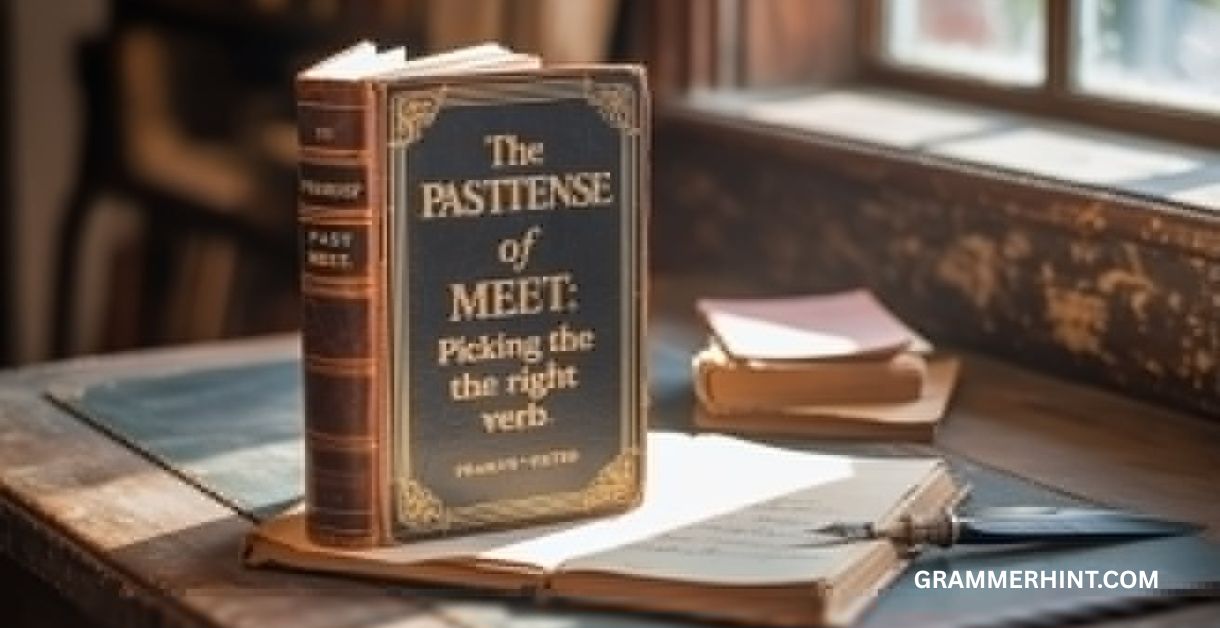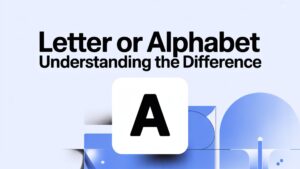Hook
Ever caught yourself wondering, “What is the past tense of meet?” especially when writing that email and hesitating between “met” or something else entirely? You’re not alone. English throws curveballs even at everyday verbs.
1. Understanding the Baseline: Meet (base form), Met, Meeting
Meet (base form) is the present tense verb you use when two or more parties come together:
- “I meet new people at conferences.”
- Or “We meet for lunch tomorrow.”
When you look at Past tense, things shift. The simple past is Met (past tense); the past participle is also Met (past participle). And if you’re in the middle of something, you’d say Meeting (present participle).
Here’s a mini verb conjugation chart:
| Tense | Form of “meet” |
|---|---|
| Present tense (simple) | meet (base form) |
| Simple past (Past tense) | met (past tense) |
| Continuous (present prog) | meeting (present participle) |
| Perfect (present) | have/has met (past participle) |
This little table should clarify your English verb forms when it comes to meet vs met grammar.
2. Irregular Verb Behavior: Why We Say “Met”

Let’s talk irregular verb life. Unlike a regular verb like “talk” → “talked,” meet flips unpredictably to met there’s no neat “meet + ed.” English has plenty of these. You’ll see this under common irregular verbs, but for now just note: meet is irregular, so you must memorize its past tense.
Word Evolution
The journey from Old English: metan to modern meet shows how verbs evolve. Originally, language patterns changed through usage, speech, phonetics shifts, and borrowed influences. The word evolution of metan helps explain why met stays monosyllabic and simple.
3. Pronunciation and Enunciation
Let’s dive into pronunciation.
- /mɛt/ is how you say “met.”
- Short ‘e’ sound—no drag.
- Nasal sound on the “m,”
- Finishing with a voiceless consonant “t.”
It’s crisp, clean, and monosyllabic—quick off the tongue. The voiceless dental plosive gives it that sharp end. If you’re teaching spoken English or fine‑tuning your enunciation, focus on that final “t.” You’ll find “met” easier to slip in when you practice saying it out loud.
4. Using “Meet” Across Tenses
Simple Tense vs Continuous vs Perfect
Simple tense (Past tense):
- I met Sarah at the bookstore.
- They met at the movie theater last night.
Continuous tense (past continuous):
- I was meeting clients when you called.
Perfect tense (present perfect or past perfect):
- I have met your sister.
- By the time we arrived, they had met already.
Affirmative, Negative, Interrogative Sentences
- Affirmative sentence: I met Julia at the airport.
- Negative sentence: I did not meet Julia before.
- Interrogative sentence: Did you meet Julia at the airport?
Notice how in the negative sentence, you use “did not meet” instead of “met not.”
5. Everyday Scenarios and Sample Emails
Let’s bring this to life with real‑world contexts—email formats help the usage feel natural.
Example 1: Email After a Conference
Subject: Great to Meet You at the Conference
Hi Dr. Patel,
It was a pleasure to meet new people like you at the networking event. I especially enjoyed how we met at the airport and had that impromptu chat about modern linguistics.
I’ve attached my abstract as promised. Please let me know when you’d like to meet for lunch next month.
Best regards,
Alex
- Here, “meet past tense” appears in “met at the airport.”
- The tone keeps it conversational.
- “Meet new people” shows present tense versus past.
Example 2: Informal Note Post‑Vacation
To: Jenna
Subject: We finally met for lunch
Hey Jenna,
I can’t believe we finally got to meet for lunch at that little café by the beach. It felt instant—like we had always known each other.
Talk soon,
Mark
- “Finally met for lunch” includes meet for lunch and met in past tense.
- Casual, smooth phrasing keeps it friendly.
Example 3: Formal Meeting Follow‑Up
Subject: Follow‑Up: Meeting with Team
Dear Mr. Nguyen,
Thank you for the opportunity to meet with you and your team yesterday. I appreciated our time meeting about the quarterly report—as well as the chance to assemble ideas for next steps.
I have met with my team since, and we plan to send a full outline by Friday.
Sincerely,
Taylor
- Multiple forms: meet, meeting, met.
- Shows both simple past and continuous/participles in action.
Example 4: Networking Event Recap
Hi Sara,
I enjoyed our conversation at the book signing. I didn’t expect you to run into the author—what a coincidence!
We must meet new people just like that at future events. Let me know when you’re free to meet for lunch, or perhaps attend another conference together.
Cheers,
Nina
- Throws in run into, a synonym for meet.
- It shows how casual meeting‑phrases appear everyday.
6. Synonyms and Subtle Differences
Using synonyms for meet helps vary your tone and style. Here’s a quick list:
- Encounter (formal): I encountered an old friend on the train.
- Convene (formal group): The committee convened to discuss policy.
- Gather: We gathered at noon.
- Connect: We connected after the seminar.
- Assemble: The team assembled before the announcement.
- Run into (casual): I run into Hermione at the cafe.
- Come across (unexpected): I came across an old journal.
Each carries a shade of meaning. For example, encounter feels chance; convene feels official.
7. Pronunciation Guide: More Depth
You’ve seen /mɛt/ for “met.” For meet (base form), it’s /miːt/.
Key contrasts:
- meet → long ‘ee’ sound.
- met → short ‘e’ sound.
That switch from long to short vowel helps your ear catch the tense change.
Pair it with phonetics notes:
- Monosyllabic both ways—super straightforward.
- Voiceless dental plosive at the end of both, but “meet” holds the vowel longer.
8. Grammar Rules and Practical Grammar Tools
Grammar Rules for Verbs
- English verb forms: meet (present), met (past), meeting (participle).
- Past tense of irregular verbs: memorize; “meet” → “met.”
- You pair with auxiliary verbs for negative or interrogative:
- Negative: didn’t + base form → didn’t meet
- Interrogative: did + subject + base form → Did you meet?
Verb usage examples
- Positive: He met all the requirements.
- Negative: He didn’t meet the deadline.
- Question: Did he meet the deadline?
Keep those patterns in mind—they’re universal.
9. Comparing “Meet” and “Encounter”
Encounter vs meet—both workable, but they differ.
- Encounter feels more formal or unexpectedly happen.
- I encountered many tourists in the city.
- Meet is more general: planned or unplanned.
- I met several tourists at the café.
Use “meet” for everyday speech; pick “encounter” when you want tone or nuance to shift.
10. A Deep Dive: Verb Tenses Table
Let’s compile a quick verb tenses table with “meet/met”:
| Tense | Form and Example |
|---|---|
| Present Simple | I meet clients weekly. |
| Past Simple (Past tense) | I met clients last week. |
| Past Continuous | I was meeting with clients when you called. |
| Present Perfect (Perfect tense) | I have met many clients this month. |
| Past Perfect | I had met the manager before the meeting began. |
| Future Simple | I will meet them tomorrow. |
| Future Perfect | I will have met everyone by Friday. |
This snapshot shows how verb conjugation flexes across time.
11. Common Pitfalls in Spoken English
When people speak quickly, “met” sometimes blurs. You might hear:
- I metcha at the party. (colloquial slur)
- Or confuse Meet in past tense with “meet” itself until stress clarifies.
To fix that, practice crisp enunciation—emphasize the short “e” and the final “t.” Read examples out loud:
- I met her yesterday.
- I meet her every week.
Feel the difference.
12. English Language Learning Tips
If you’re studying English language learning, here’s how to master “meet”:
- Drill the English verb forms: present, past, participle.
- Flashcards: “meet / met / met.”
- Use them in affirmative, negative, and interrogative sentences.
- Speak them aloud—focus on pronunciation, especially that voiceless dental plosive.
- Write example conversations or emails (like above) to reinforce usage.
- Note other common irregular verbs and compare patterns.
13. Scenarios: More Real‑Life Uses
Scenario: Book Signing or Author Event
At a book signing, you might say:
- “I met the author after a long line.”
- Or more casually: I ran into the author backstage—a surprise.
These events help you practice meet for lunch, meet new people, and conferences use cases at once.
Scenario: Group Convention
At a conference, you might:
- Meet new people, connect with peers, or gather to discuss ideas.
- Example line: Our group assembled in the hall. I met 12 speakers and engaged in deep chats.
Each phrase gives flavor—choose based on tone.
14. Recap: Why “Met” Works
In short:
- Meet past tense is always met—it’s an irregular verb.
- You use it in the simple tense, while meeting serves continuous, and met also doubles as the past participle.
- Pronounce it /mɛt/: short ‘e’, crisp ‘t’, monosyllabic.
- Use affirmative, negative, interrogative forms with “did” for past.
- Oils in your writing and speaking come from synonyms—encounter, convene, etc.—matching tone.
- Emails, casual chat, or formal writing—met fits everywhere.
- Just watch your enunciation to avoid slurring.
15. Final Thoughts: Bringing It All Together
By now, you’ve seen:
- A solid verb conjugation chart
- The scoop on meet vs met grammar, pronunciation, phonetics, syntax
- Real email templates and everyday examples that feel alive, not robotic
- Helpful synonyms and nuance
- Guidance for English learners and writers alike
You’ve reinforced that “met” is your go‑to past tense of meet, easy to remember once you drill it with purpose. Give these examples a read aloud; let them sink in. Over time, your familiarity grows—no more second‑guessing.
Hook
Ever caught yourself wondering, “What is the past tense of meet?”—especially when writing that email and hesitating between “met” or something else entirely? You’re not alone. English throws curveballs even at everyday verbs. In this article, we’ll slice through confusion with clarity. We’ll explore meet past tense, meet past form, and how it behaves across simple tense, continuous tense, and perfect tense. You’ll see not just definitions, but real scenarios, handy emails, and voice-friendly examples. Let’s jump in.
1. Understanding the Baseline: Meet (base form), Met, Meeting
Meet (base form) is the present tense verb you use when two or more parties come together:
- “I meet new people at conferences.”
- Or “We meet for lunch tomorrow.”
When you look at Past tense, things shift. The simple past is Met (past tense); the past participle is also Met (past participle). And if you’re in the middle of something, you’d say Meeting (present participle).
Here’s a mini verb conjugation chart:
| Tense | Form of “meet” |
|---|---|
| Present tense (simple) | meet (base form) |
| Simple past (Past tense) | met (past tense) |
| Continuous (present prog) | meeting (present participle) |
| Perfect (present) | have/has met (past participle) |
This little table should clarify your English verb forms when it comes to meet vs met grammar.
2. Irregular Verb Behavior: Why We Say “Met”
Let’s talk irregular verb life. Unlike a regular verb like “talk” → “talked,” meet flips unpredictably to met—there’s no neat “meet + ed.” English has plenty of these. You’ll see this under common irregular verbs, but for now just note: meet is irregular, so you must memorize its past tense.
Word Evolution
The journey from Old English: metan to modern meet shows how verbs evolve. Originally, language patterns changed through usage, speech, phonetics shifts, and borrowed influences. The word evolution of metan helps explain why met stays monosyllabic and simple.
3. Pronunciation and Enunciation
Let’s dive into pronunciation.
- /mɛt/ is how you say “met.”
- Short ‘e’ sound—no drag.
- Nasal sound on the “m,”
- Finishing with a voiceless consonant “t.”
It’s crisp, clean, and monosyllabic—quick off the tongue. The voiceless dental plosive gives it that sharp end. If you’re teaching spoken English or fine‑tuning your enunciation, focus on that final “t.” You’ll find “met” easier to slip in when you practice saying it out loud.
4. Using “Meet” Across Tenses
Simple Tense vs Continuous vs Perfect
Simple tense (Past tense):
- I met Sarah at the bookstore.
- They met at the movie theater last night.
Continuous tense (past continuous):
- I was meeting clients when you called.
Perfect tense (present perfect or past perfect):
- I have met your sister.
- By the time we arrived, they had met already.
Affirmative, Negative, Interrogative Sentences
- Affirmative sentence: I met Julia at the airport.
- Negative sentence: I did not meet Julia before.
- Interrogative sentence: Did you meet Julia at the airport?
Notice how in the negative sentence, you use “did not meet” instead of “met not.”
5. Everyday Scenarios and Sample Emails
Let’s bring this to life with real‑world contexts—email formats help the usage feel natural.
Example 1: Email After a Conference
Subject: Great to Meet You at the Conference
Hi Dr. Patel,
It was a pleasure to meet new people like you at the networking event. I especially enjoyed how we met at the airport and had that impromptu chat about modern linguistics.
I’ve attached my abstract as promised. Please let me know when you’d like to meet for lunch next month.
Best regards,
Alex
- Here, “meet past tense” appears in “met at the airport.”
- The tone keeps it conversational.
- “Meet new people” shows present tense versus past.
Example 2: Informal Note Post‑Vacation
To: Jenna
Subject: We finally met for lunch
Hey Jenna,
I can’t believe we finally got to meet for lunch at that little café by the beach. It felt instant—like we had always known each other.
Talk soon,
Mark
- “Finally met for lunch” includes meet for lunch and met in past tense.
- Casual, smooth phrasing keeps it friendly.
Example 3: Formal Meeting Follow‑Up
Subject: Follow‑Up: Meeting with Team
Dear Mr. Nguyen,
Thank you for the opportunity to meet with you and your team yesterday. I appreciated our time meeting about the quarterly report—as well as the chance to assemble ideas for next steps.
I have met with my team since, and we plan to send a full outline by Friday.
Sincerely,
Taylor
- Multiple forms: meet, meeting, met.
- Shows both simple past and continuous/participles in action.
Example 4: Networking Event Recap
Hi Sara,
I enjoyed our conversation at the book signing. I didn’t expect you to run into the author—what a coincidence!
We must meet new people just like that at future events. Let me know when you’re free to meet for lunch, or perhaps attend another conference together.
Cheers,
Nina
- Throws in run into, a synonym for meet.
- It shows how casual meeting‑phrases appear everyday.
6. Synonyms and Subtle Differences
Using synonyms for meet helps vary your tone and style. Here’s a quick list:
- Encounter (formal): I encountered an old friend on the train.
- Convene (formal group): The committee convened to discuss policy.
- Gather: We gathered at noon.
- Connect: We connected after the seminar.
- Assemble: The team assembled before the announcement.
- Run into (casual): I run into Hermione at the cafe.
- Come across (unexpected): I came across an old journal.
Each carries a shade of meaning. For example, encounter feels chance; convene feels official.
7. Pronunciation Guide: More Depth
You’ve seen /mɛt/ for “met.” For meet (base form), it’s /miːt/.
Key contrasts:
- meet → long ‘ee’ sound.
- met → short ‘e’ sound.
That switch from long to short vowel helps your ear catch the tense change.
Pair it with phonetics notes:
- Monosyllabic both ways—super straightforward.
- Voiceless dental plosive at the end of both, but “meet” holds the vowel longer.
8. Grammar Rules and Practical Grammar Tools
Grammar Rules for Verbs
- English verb forms: meet (present), met (past), meeting (participle).
- Past tense of irregular verbs: memorize; “meet” → “met.”
- You pair with auxiliary verbs for negative or interrogative:
- Negative: didn’t + base form → didn’t meet
- Interrogative: did + subject + base form → Did you meet?
Verb usage examples
- Positive: He met all the requirements.
- Negative: He didn’t meet the deadline.
- Question: Did he meet the deadline?
Keep those patterns in mind they’re universal.
9. Comparing “Meet” and “Encounter”
Encounter vs meet both workable, but they differ.
- Encounter feels more formal or unexpectedly happen.
- I encountered many tourists in the city.
- Meet is more general: planned or unplanned.
- I met several tourists at the café.
Use “meet” for everyday speech; pick “encounter” when you want tone or nuance to shift.
10. A Deep Dive: Verb Tenses Table
Let’s compile a quick verb tenses table with “meet/met”:
| Tense | Form and Example |
|---|---|
| Present Simple | I meet clients weekly. |
| Past Simple (Past tense) | I met clients last week. |
| Past Continuous | I was meeting with clients when you called. |
| Present Perfect (Perfect tense) | I have met many clients this month. |
| Past Perfect | I had met the manager before the meeting began. |
| Future Simple | I will meet them tomorrow. |
| Future Perfect | I will have met everyone by Friday. |
This snapshot shows how verb conjugation flexes across time.
11. Common Pitfalls in Spoken English
When people speak quickly, “met” sometimes blurs. You might hear:
- I metcha at the party. (colloquial slur)
- Or confuse Meet in past tense with “meet” itself until stress clarifies.
To fix that, practice crisp enunciation—emphasize the short “e” and the final “t.” Read examples out loud:
- I met her yesterday.
- I meet her every week.
Feel the difference.
12. English Language Learning Tips
If you’re studying English language learning, here’s how to master “meet”:
- Drill the English verb forms: present, past, participle.
- Flashcards: “meet / met / met.”
- Use them in affirmative, negative, and interrogative sentences.
- Speak them aloud—focus on pronunciation, especially that voiceless dental plosive.
- Write example conversations or emails (like above) to reinforce usage.
- Note other common irregular verbs and compare patterns.
13. Scenarios: More Real‑Life Uses
Scenario: Book Signing or Author Event
At a book signing, you might say:
- “I met the author after a long line.”
- Or more casually: I ran into the author backstage—a surprise.
These events help you practice meet for lunch, meet new people, and conferences use cases at once.
Scenario: Group Convention
At a conference, you might:
- Meet new people, connect with peers, or gather to discuss ideas.
- Example line: Our group assembled in the hall. I met 12 speakers and engaged in deep chats.
Each phrase gives flavor—choose based on tone.
14. Recap: Why “Met” Works
In short:
- Meet past tense is always met—it’s an irregular verb.
- You use it in the simple tense, while meeting serves continuous, and met also doubles as the past participle.
- Pronounce it /mɛt/: short ‘e’, crisp ‘t’, monosyllabic.
- Use affirmative, negative, interrogative forms with “did” for past.
- Oils in your writing and speaking come from synonyms—encounter, convene, etc.—matching tone.
- Emails, casual chat, or formal writing—met fits everywhere.
- Just watch your enunciation to avoid slurring.
15. Final Thoughts: Bringing It All Together
By now, you’ve seen:
- A solid verb conjugation chart
- The scoop on meet vs met grammar, pronunciation, phonetics, syntax
- Real email templates and everyday examples that feel alive, not robotic
- Helpful synonyms and nuance
- Guidance for English learners and writers alike
You’ve reinforced that “met” is your go‑to past tense of meet, easy to remember once you drill it with purpose. Give these examples a read aloud; let them sink in. Over time, your familiarity grows no more second‑guessing.









